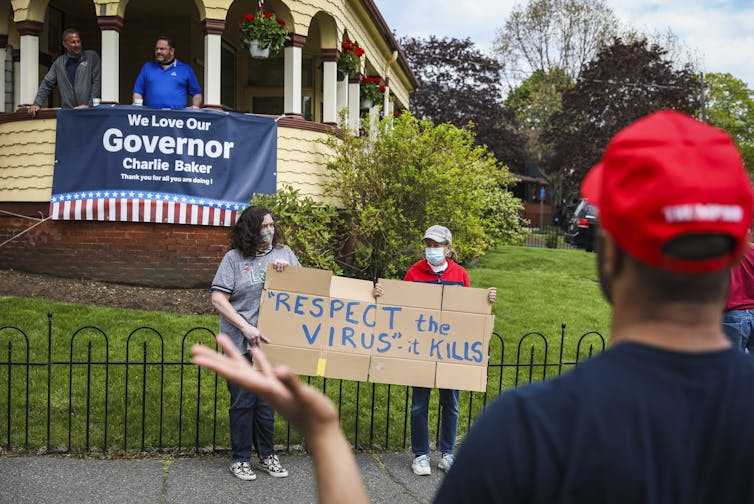Emotion is a big part of how you assess risk – and why it's so hard to be objective about pandemic precautions
- Written by Sheldon H. Jacobson, Professor of Computer Science, University of Illinois at Urbana-Champaign
People tend to overestimate or underestimate risk. The pandemic brings this into stark relief. Picture someone wearing an N95 mask while walking their dog through a deserted park. Contrast that with someone entering a crowded bar maskless in an area with high coronavirus transmission rates.
Risk is a function of logical and physical factors, both qualitative and quantitative. A computer could combine them all into a measure that captures the likelihood, benefits and cost of an event occurring.
But people are prone to assess risk emotionally. This tendency explains why many view flying as riskier than driving, even though the reverse is true[1].
What people often confuse with risk is lack of control[2]. That’s one reason many have concerns about self-driving vehicles[3], where artificial intelligence algorithms[4] control the steering and braking.
People accept risks when they favorably weigh the perceived or potential benefits against the associated costs[5]. That trade-off explains why people gamble on casino games and lotteries, even though their expected return is negative[6].
As a data scientist[7] with expertise in data-driven decision-making under uncertainty, I’ve been watching how people react to coronavirus risks since the beginning of the pandemic. Choosing to be vaccinated, for instance, involves numerous factors – personal and public – that must be weighed to inform decisions. For some, this decision is obvious. For others, it is shrouded in fog.
At the heart of all such decisions is how you as an individual assess risk and make decisions based on your assessments. What are the different perspectives that lead to different ways to assess risk? Building bridges between such perspectives is crucial to reach a healthy societal compromise.
 When making decisions, one part of the population focuses on the threat from the coronavirus.
Erin Clark/The Boston Globe via Getty Images[8]
When making decisions, one part of the population focuses on the threat from the coronavirus.
Erin Clark/The Boston Globe via Getty Images[8]
One pandemic, different perspectives
There are two general COVID-19 perspectives; let’s call them receptive and skeptical. A wide schism of risk beliefs about the virus and the vaccines separate these two groups.
As a whole, the receptive faction views the pandemic scientifically. In general, they are emotionally charged when considering its impact and the path forward, viewing it as a major public health crisis. They know that many lives have been lost in the U.S., and support the societal responses taken so far – actions like stay-at-home orders, school closings and indoor dining shutdowns. They view the delta variant as the most recent emerging threat. They accept the value of wearing face coverings in public and feel everyone should be vaccinated.
In contrast, the skeptical faction generally views the virus to be on the same level of concern as seasonal influenza or the common cold. They recognize that many have died, but believe that these people likely already had other health problems, so the virus just hastened their demise. They question the benefits of the societal responses taken so far. Many believe a previous infection will protect them against the delta variant and that face coverings are ineffective for stopping the spread of the virus. They are wary of the vaccines – except possibly for people who really need it, like the elderly – preferring natural immunity as their best defense.
Both perceptions contain a mix of valid observations, flawed beliefs and misinformation.
The receptive perception reflects an aversion to risk. Those in this group overestimate the risk of the virus at the personal level. As such, they treat worst-case scenarios as expected outcomes. For this group, the benefits of responses outweigh their costs.
The skeptical perception reflects a high tolerance for risk. Their actions suggest that they underestimate the risk of the virus at the population level. As such, they treat best-case scenarios as expected outcomes. This group believes that the benefits of responses in the past did not warrant their costs.
Finding a risk compromise
The middle ground is where the truth lies, and risk can be assessed. So what is this fact-based middle ground?
With so many factors contributing to the vaccine benefits and costs nexus, informed decision-making requires risk assessment that at best is challenging and at worst is simply overwhelming. This pushes people to simplify their decision process down to a single factor, effectively narrowing their risk assessment.
 Another part of the population perceives public health guidelines as government overstepping.
David McNew/Getty Images News via Getty Images[9]
Another part of the population perceives public health guidelines as government overstepping.
David McNew/Getty Images News via Getty Images[9]
The field of decision analysis[10] was created to inform such complex processes. It provides a set of tools to systematically balance multiple criteria when making a decision.
Even with all the data available, both receptive and skeptical factions base their assessment of risk on emotion. Receptive people are fearful of the virus’s impact[11] on themselves and the population, and are willing to accept interventions recommended by public health officials to ameliorate any such outcomes. The end result are behaviors that help reduce, but not stop, the spread of the virus.
Skeptical people are distrustful[12] of interventions espoused by government agencies like the U.S. Centers for Disease Control and Prevention, believing they are unnecessary[13] and threaten livelihoods, personal well-being and personal choice. The end result are behaviors that do not help reduce the spread of the virus, since they believe the need to stop it is exaggerated.
People with receptive and skeptical perceptions of the virus have not been able to find much common ground. The same conflicts exist around solutions to climate change[14] and other political policies in the U.S. related to things like economic growth[15] and job creation[16].
[Over 100,000 readers rely on The Conversation’s newsletter to understand the world. Sign up today[17].]
Overcoming philosophical divides requires each faction to feel safe in its position and be provided with the opportunity to be heard[18]. Using data and facts to build consensus[19] can be effective. With multiple criteria weighted differently by each faction, everyone can be a decision analyst to help reach common ground for compromise.
Steps like these would help bridge the coronavirus-response divide – and possibly even help end the social chaos that erupted in response to the pandemic. It’s hard to imagine enough Americans setting aside the emotion at this point, though, to dispassionately calculate costs and benefits around vaccination, masking and all the other public health interventions.
There is a path forward – the key to ending the pandemic is getting both factions to walk it together.
References
- ^ the reverse is true (traveltips.usatoday.com)
- ^ lack of control (www.fairinstitute.org)
- ^ self-driving vehicles (www.natlawreview.com)
- ^ artificial intelligence algorithms (www.technologyreview.com)
- ^ weigh the perceived or potential benefits against the associated costs (www.investopedia.com)
- ^ expected return is negative (www.ncsl.org)
- ^ As a data scientist (scholar.google.com)
- ^ Erin Clark/The Boston Globe via Getty Images (www.gettyimages.com)
- ^ David McNew/Getty Images News via Getty Images (www.gettyimages.com)
- ^ decision analysis (www.investopedia.com)
- ^ fearful of the virus’s impact (doi.org)
- ^ Skeptical people are distrustful (doi.org)
- ^ believing they are unnecessary (www.kff.org)
- ^ climate change (www.forbes.com)
- ^ economic growth (www.jec.senate.gov)
- ^ job creation (en.wikipedia.org)
- ^ Sign up today (theconversation.com)
- ^ feel safe in its position and be provided with the opportunity to be heard (www.jec.senate.gov)
- ^ data and facts to build consensus (phys.org)
Authors: Sheldon H. Jacobson, Professor of Computer Science, University of Illinois at Urbana-Champaign

